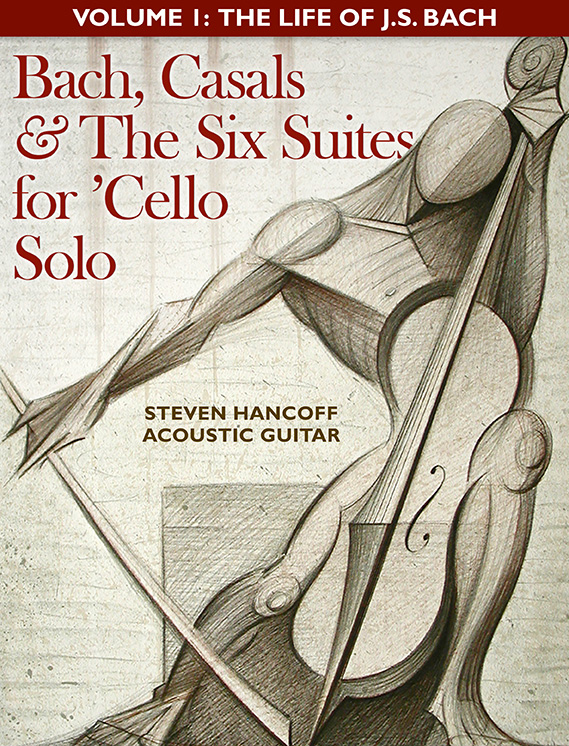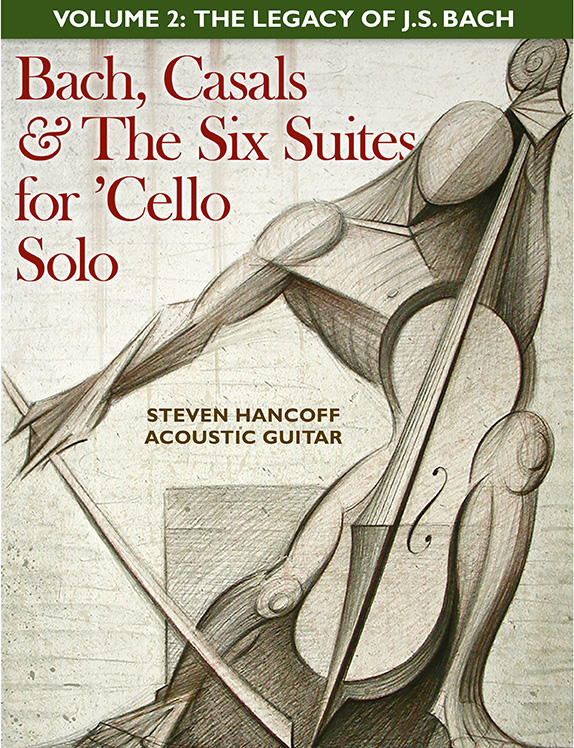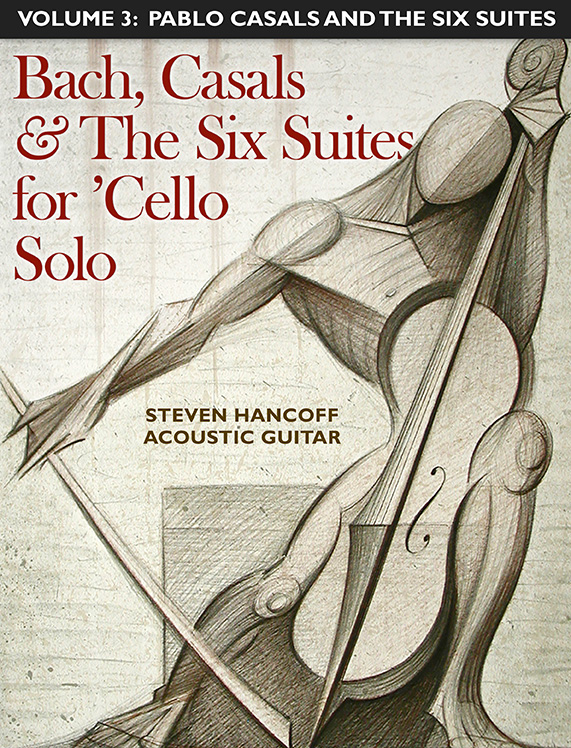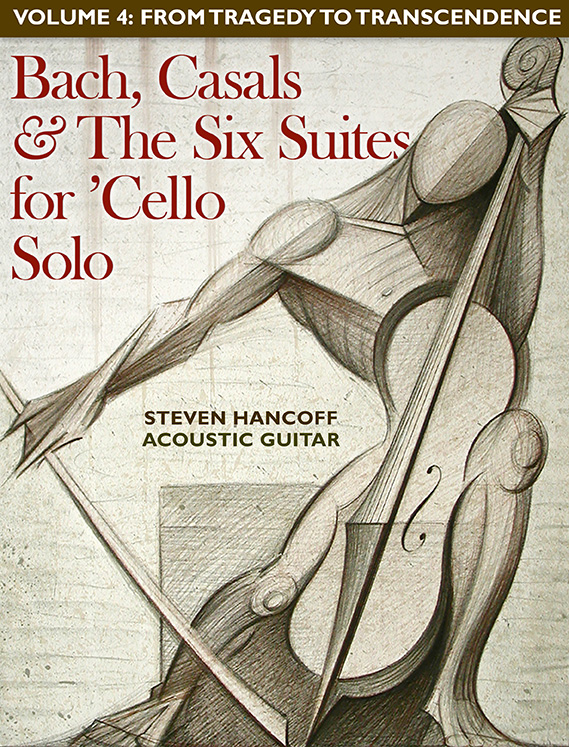From the Heart
WHEN I WAS FIRST SMITTEN with the desire to transcribe and record the Six Suites for Cello Solos, the entire idea was to transform each of the 36 movements – six pieces of music in each of six suites – into music for the guitar. I had fallen in love with the music back in the 1980’s, and as I was approaching my 60th birthday, the timing felt right. That is to say, it was now or never!
Transcription is not merely the transferring of notes from one instrument to another. Transcription here is the art of creating a piece of guitar music out of a piece of cello music. One of the central issues that was necessary to confront was this: cello is a one-note-at-a-time instrument – you can't play separate, concurrent melodic lines and you can't play chords. In short, this means a cello soloist can play melody but not harmony.
A guitar, on the other hand, is idiomatically suited, or even designed, for the musician to do all these things. So, transcription here ultimately means harmonizing the Bach Cello Suites.Every day I practiced two suites – twelve pieces of music – by Johann Sebastian Bach. Normally, when a musician is working on a piece of music, he memorizes it, both mentally and muscularly. This practice was essentially different in that I had to struggle to not memorize because, whenever a new harmonic idea occurred to me, I kept on changing the transcriptions. And of course, the more I practiced the Suites, the more intimate I became with them, and so the more ideas came my way.
Early on, it dawned on me that familiarizing myself with the life of this man might deepen my understanding of who he was, and that understanding would serve me to better organize the music. So, I began to read biographies. And the more I read, the more I wrote. This man, "the miracle of Bach," as Pablo Casals once put it, led a life of unfathomable creativity and giftedness on the one hand and neglect and immense tragedy on the other.
He was orphaned at nine. He was widowed at the height of professional and familial contentedness. He fathered twenty children, and buried eleven of them. Yet, there is absolutely no hint of any sense of existential victimization or resentment about the most intimate and most primal circumstances of his life: the deaths of the people closest to him.
In fact, a person cannot find anything in Bach's music except an abundance of majesty, poignancy, grace, regality, tenderness, a mighty intelligence, all cloaked in transcendent beauty, exquisite musical craftsmanship, and the highest degree of virtuosity. Seeking to fathom just how Johann Sebastian Bach did what he did in the circumstances in which he did it impelled me every day to deepen my relationship with this music, and even with an emotional/mental image of the man himself.
It seems inevitable that we idealize the greatest among us. It is difficult for us to grasp that this was a flesh and blood human being who faced the same challenges of life that we all do – marriage, bosses, rent to pay, bills to meet, children to raise… I thought that if I could present visually what I was describing with words – portraits of the men and women about whom I was writing, pictures of the towns and villages whose streets they walked, images of the antique musical instruments they played, documents in Bach's own hand … these might put some flesh on the bones of the story. So, as I came upon more and more historical art and documents pertaining to his life and times, I began to insert them into my text. That process flowered. By now, there are hundreds upon hundreds of historical pictures and documents that illustrate his remarkable story, and we now have here the largest collection of Bachiana that has ever been compiled and made available in one place.
I also knew that many contemporary artists have created art inspired by Bach. So, I began to contact artists whose work had come to my attention to request permission to include their art. To my eternal gratitude, almost universally, artists -- both world renowned and unknown – generously and enthusiastically contributed pictures. The project now includes the works of more than 200 contemporary artists. A lesson here is that the influence of Sebastian Bach continues to pervade our modern, and clearly more cynical and dangerous, age.
Added to all this is the indispensable role of Pablo Casals in rescuing the Cello Suites from oblivion. In short, on the very day that Casals’ father bought the thirteen-year old child his first cello, Casals came upon a dusty manuscript of the Cello Suites in an obscure second-hand bookstore near the Barcelona docks. As far as anyone can discern, no-one had ever actually played the Cello Suites from the time Bach composed them in 1720. Casals later wrote that he practiced them daily for twelve years before summoning the courage to present one in public. So, for about 200 years they lay dormant, and by sheer dumb luck, or for the more metaphysically inclined by some other hidden force, it turned out to be Pablo Casals of all people who found them, and brought them to light. To me, this is far and away the most serendipitous saga in the history of the arts, or even of western culture itself.
And last, for those of you so inclined, I am making available free of charge – the transcriptions themselves, both in standard musical notation and in tablature, so that guitarists can try their hands at playing this music – or as the great cellist Mischa Maisky called it, “Dictation from God.” I expect you will find there an inherent and deep pleasure – not to mention a grand challenge!
Immersing myself in the genius of Bach – having done so makes obvious that we use the word “genius” far, far too liberally these days – has enriched my life beyond what I can possibly articulate here. I am so excited that this life-project of mine is now making its way into the wide world. I can only hope that listeners and readers and musicians alike will also feel enriched for having partaken of it.
—Steven Hancoff
To Download Steven’s Guitar Transcriptions of All 36 of Bach’s Masterpieces, enter your email address below
Read all four volumes in iBooks Volume 1: The Life of J. Sebastian Bach is the story of the great man’s life… Did you know that by the time he was nine years old, Bach had witnessed the death of three siblings, and then in one year the death of his father and then his mother? Or that at the age of 35, after three of his children had died, his wife – Maria Barbara Bach, the love of his life – died? Or that he lived the last 27 years of his life in obscurity, turning out masterpieces even while holding down a day job teaching Latin and leading a boys’ choir? read more
Volume 1: The Life of J. Sebastian Bach is the story of the great man’s life… Did you know that by the time he was nine years old, Bach had witnessed the death of three siblings, and then in one year the death of his father and then his mother? Or that at the age of 35, after three of his children had died, his wife – Maria Barbara Bach, the love of his life – died? Or that he lived the last 27 years of his life in obscurity, turning out masterpieces even while holding down a day job teaching Latin and leading a boys’ choir? read more Volume 2: The Legacy of J. Sebastian Bach tells the tale of his death at the hands of a quack, his remarkable family – he fathered five sons all of whom were more renowned as composers in their lifetimes than he was in his! -, the 80 years of near-total obscurity following his death, the discovery and bringing to light his incomparable work by the teen-aged Felix Mendelssohn, and finally the gathering together of the more than 1,000 extant works – probably only a bit more than half of his life’s work. As Beethoven said of him: “His name should not have been Bach (“Bach” means stream or brook in German.). It should have been Ocean."read more
Volume 2: The Legacy of J. Sebastian Bach tells the tale of his death at the hands of a quack, his remarkable family – he fathered five sons all of whom were more renowned as composers in their lifetimes than he was in his! -, the 80 years of near-total obscurity following his death, the discovery and bringing to light his incomparable work by the teen-aged Felix Mendelssohn, and finally the gathering together of the more than 1,000 extant works – probably only a bit more than half of his life’s work. As Beethoven said of him: “His name should not have been Bach (“Bach” means stream or brook in German.). It should have been Ocean."read more Volume 3: Pablo Casals and the Six Suites for ‘Cello Solo is actually two books in one. First, the dynamic and heroic life of Pablo Casals, and the spectacularly unlikely serendipity of his having stumbled upon Bach’s Cello Suites when he was only 13 years old, and his artistic vision and perseverance in working on them and bringing them to life 12 years later may well be the single greatest cultural contribution of any 20th century artist.read more
Volume 3: Pablo Casals and the Six Suites for ‘Cello Solo is actually two books in one. First, the dynamic and heroic life of Pablo Casals, and the spectacularly unlikely serendipity of his having stumbled upon Bach’s Cello Suites when he was only 13 years old, and his artistic vision and perseverance in working on them and bringing them to life 12 years later may well be the single greatest cultural contribution of any 20th century artist.read more Volume 4: From Tragedy to Transcendence consists almost entirely of nine animated videos, and seeks to articulate the mystery of the greatness of Bach: he did not let personal tragedy define his life, nor turn him to negativity. Rather, the miracle of Bach is in his ability to unify the expression of breathtaking beauty, primal emotion, vast power and intellectual rigor, and to do so on a giant canvas. read more
Volume 4: From Tragedy to Transcendence consists almost entirely of nine animated videos, and seeks to articulate the mystery of the greatness of Bach: he did not let personal tragedy define his life, nor turn him to negativity. Rather, the miracle of Bach is in his ability to unify the expression of breathtaking beauty, primal emotion, vast power and intellectual rigor, and to do so on a giant canvas. read more